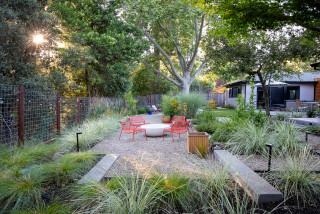8. Skimping on Borders
“Many clients understandably don’t want a high-maintenance [yard] and this seems to manifest in them asking for narrow flower beds, as these will require less work — right?” Reader says. “Actually, this is wrong.”
Solution: Use shrubs. “The best low-maintenance plants are shrubs,” Reader says. “They last many years, don’t require a lot of looking after and can deliver interesting structure, flowers, berries and autumn leaf color — and many of them are evergreen, so look good in winter too.
“The thing about shrubs, though, is many of them will get quite big,” he continues. “So if you put them in a narrow bed, you’ll fairly quickly be having to cut them back frequently, as they’ll overhang the lawn or paths. This destroys the beauty of their natural shape, creates woody holes in the foliage canopy and creates maintenance.
“By having a wider bed to start with, the shrubs can be gently pruned as they reach their mature size every three to five years and be kept looking beautiful,” he says.

“Many clients understandably don’t want a high-maintenance [yard] and this seems to manifest in them asking for narrow flower beds, as these will require less work — right?” Reader says. “Actually, this is wrong.”
Solution: Use shrubs. “The best low-maintenance plants are shrubs,” Reader says. “They last many years, don’t require a lot of looking after and can deliver interesting structure, flowers, berries and autumn leaf color — and many of them are evergreen, so look good in winter too.
“The thing about shrubs, though, is many of them will get quite big,” he continues. “So if you put them in a narrow bed, you’ll fairly quickly be having to cut them back frequently, as they’ll overhang the lawn or paths. This destroys the beauty of their natural shape, creates woody holes in the foliage canopy and creates maintenance.
“By having a wider bed to start with, the shrubs can be gently pruned as they reach their mature size every three to five years and be kept looking beautiful,” he says.